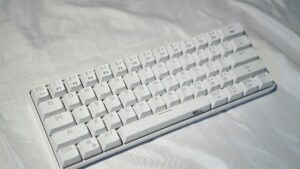Introduction: Laptop Keyboard
The laptop keyboard is an essential component that greatly impacts the user experience. Whether you’re a student, professional, gamer, or casual user, the type and quality of a keyboard can affect productivity, comfort, and efficiency. In this comprehensive guide, we will cover various types of laptop keyboards, their features, common issues and troubleshooting tips, and maintenance tips. By the end, you’ll have a solid understanding of what to look for in a keyboard and how to maintain it for the best performance.
Table of Contents
- Types of Laptop Keyboards
- Key Features to Consider
- Common Keyboard Issues and Troubleshooting
- Laptop Keyboard Maintenance Tips
- Laptop Keyboard Comparison Table
Types of Laptop Keyboards
1. Membrane Keyboards
Membrane keyboards are widely used in laptops due to their low cost and slim design. They operate by pressing keys against a flexible, pressure-sensitive membrane to make contact with the circuitry underneath.
- Pros: Lightweight, affordable, and quieter.
- Cons: Less tactile feedback, shorter lifespan.
2. Mechanical Keyboards
Mechanical keyboards are less common in laptops but are highly valued by professionals and gamers. Each key has an individual mechanical switch that offers more tactile feedback and durability.
- Pros: Highly durable, responsive, customizable.
- Cons: Heavier, louder, more expensive.
3. Scissor-Switch Keyboards
Scissor-switch keyboards use a mechanism similar to membrane keyboards but with an additional scissor-like structure that provides stability and more responsive keystrokes.
- Pros: Thin profile, stable, quiet.
- Cons: Limited key travel, moderate durability.
4. Chiclet Keyboards
Also known as “island-style” keyboards, chiclet keyboards feature keys with square, flat tops and rounded edges. Most modern laptops use this design because it offers a sleek look and a comfortable typing experience.
- Pros: Stylish, easy to clean, commonly found.
- Cons: May lack tactile feedback.
Key Features to Consider Laptop Keyboard

Choosing the right laptop keyboard goes beyond aesthetics; it involves functionality, durability, and user comfort. Here are essential features to consider:
- Key Travel: Key travel refers to the distance a key must be pressed before it registers a keystroke. Mechanical keyboards often have deeper key travel, which can improve accuracy.
- Backlighting: Backlit keyboards are ideal for low-light environments, helping users work in dim conditions without external lighting.
- Keyboard Layout: Most keyboards use the QWERTY layout, but there are regional variations and specialized layouts like AZERTY or DVORAK.
- Durability: Mechanical keyboards generally last longer than membrane ones, while scissor-switch keyboards offer a good balance between longevity and comfort.
- Anti-Ghosting: Ghosting refers to unintended keystrokes, which can be an issue for fast typists and gamers. Anti-ghosting technology ensures each keystroke is registered accurately.
- Customizability: Some keyboards, especially mechanical ones, allow users to customize keycaps, switches, and RGB lighting for a personalized experience.
Common Keyboard Issues and Troubleshooting Laptop Keyboard
Laptop keyboards can encounter a variety of issues over time. Here are some common problems and how to address them:
1. Unresponsive Keys
- Cause: Dust buildup, damaged hardware, or driver issues.
- Solution: Clean the keyboard using compressed air, check for driver updates, and test with an external keyboard to rule out hardware issues.
2. Sticky Keys
- Cause: Spills or debris trapped under keys.
- Solution: Carefully clean around the keys with a soft brush or remove specific keys to clean beneath them if the model allows.
3. Key Repeat Problem
- Cause: Faulty hardware, outdated drivers, or incorrect keyboard settings.
- Solution: Check the keyboard settings in the operating system, ensure drivers are updated, and replace faulty keys if necessary.
4. Backlight Not Working
- Cause: Hardware or software issue, or power-saving settings.
- Solution: Ensure the laptop isn’t in power-saving mode, update keyboard drivers, or adjust backlight settings in the BIOS or operating system.
5. Keyboard Lag
- Cause: Software lag, background processes, or connection issues in wireless keyboards.
- Solution: Close unnecessary programs, check for software updates, and reset wireless connections if applicable.
Laptop Keyboard Maintenance Tips
Proper maintenance can extend the lifespan of your laptop keyboard and enhance its performance. Here are some tips:
- Regular Cleaning: Dust, crumbs, and dirt can accumulate over time. Use compressed air to remove debris and wipe the keys with a microfiber cloth.
- Avoid Liquid Exposure: Liquids can cause irreversible damage. Consider using a keyboard cover if you often drink beverages near your laptop.
- Use Keyboard Covers: Silicone or plastic covers can help keep dust, spills, and debris out.
- Avoid Excessive Pressure: Typing with heavy pressure can wear down keys faster. Aim to type with a light touch.
- Software Updates: Keeping your drivers up to date can prevent compatibility issues that affect keyboard performance.
Laptop Keyboard Comparison Table

| Keyboard Type | Key Travel | Durability | Noise Level | Ideal For |
|---|---|---|---|---|
| Membrane | Short | Moderate | Quiet | Basic tasks, light usage |
| Mechanical | Long | High | Loud | Gaming, professional typing |
| Scissor-Switch | Medium | High | Quiet | Everyday use, portable laptops |
| Chiclet | Short | Moderate | Quiet | General use, office work |
Conclusion: Laptop Keyboard
Choosing the right laptop keyboard involves balancing comfort, durability, and specific user needs. Each keyboard type—whether membrane, mechanical, scissor-switch, or chiclet—has unique features suited to different preferences and usage scenarios. Additionally, understanding common keyboard issues and maintenance can help you avoid disruptions and keep your keyboard in excellent working condition.
Read Aslo: Ultimate Guide to Laptop Chargers: Types, Compatibility, and Tips for Buying


